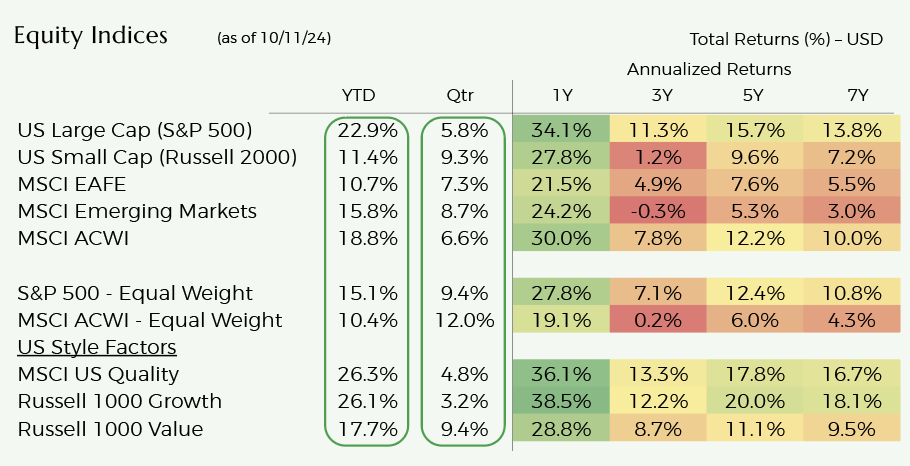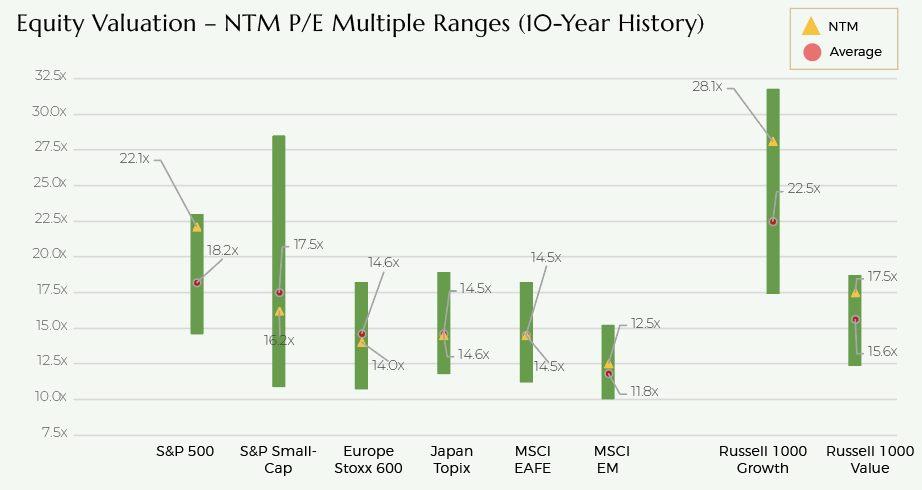Performance
Global equity markets, as tracked by the MSCI ACWI Index, rose 6.6% in Q3, bringing year-to-date (YTD) gains to 18.8% as of October 11, 2024.

Regional & Style-Factor Performance
U.S. large-cap equities (S&P 500) advanced by 5.8% in Q3, achieving a strong 22.9% YTD return. While international developed equities (+7.3% in Q3, +10.7% YTD) and emerging market stocks (+8.7% in Q3, +15.8% YTD) outperformed U.S. large caps during the third quarter, they have lagged behind on a YTD basis.
Globally, value stocks surged by 9.8% in Q3, significantly outperforming growth stocks, which gained 4.1%. Despite this recent trend, growth stocks have led the way YTD, up 21.0% compared to 17.0% for value stocks.
During Q3, the financials (+10.7%), industrials (+10.2%), and consumer discretionary (+9.4%) sectors were top performers, while energy (-2.2%) and technology (+1.1%) lagged. YTD, the technology (+28.7%) and communications services (+25.1%) sectors have delivered the best results.
U.S. Equities
Encouragingly, Q3 saw a broadening of performance within the S&P 500, extending beyond just the Magnificent Seven. The S&P 500 Equal Weight Index posted a 9.4% gain, outperforming the market-cap weighted index (+5.8%) for the first time since 2022.
During Q3, industrials (+11.4%) and financials (+10.5%) sectors performed best, while energy (-2.3%) and technology sectors (+1.6%) performed worst. Technology and internet stocks faced mixed outcomes following Q2 earnings, as lofty expectations weighed on investor sentiment. In particular, stocks of companies with ambitious capital expenditure plans for AI saw enthusiasm cool.
U.S. small-cap stocks finally outpaced large caps in Q3, delivering a 9.3% gain, compared to 5.8% for large caps.
However, YTD, the primary drivers of equity gains have still been several large-cap technology companies (NVIDIA, Meta, Apple, Microsoft, Google) with significant exposure to AI-driven growth (as was the case in 2023). The Magnificent Seven accounted for nearly half of the S&P 500’s YTD gains, with NVIDIA alone contributing 23% of the index’s returns.
On an equal-weighted basis, the S&P 500 was up 15.1% YTD, trailing the market-cap weighted index by approximately 7.8%, one of the largest differentials in history, echoing a similar trend from 2023.
YTD, small caps are up only 11.8%, significantly underperforming large caps (+22.9%). Their lagging performance has been due to lower exposure to AI, higher interest costs from greater leverage, and prior concerns over economic slowdowns. Looking ahead, small caps may be well-positioned to outperform if a “Goldilocks” scenario materializes, with rate cuts and better-than-expected economic growth, especially given their relatively cheaper valuations.
International Developed Market Equities
The MSCI EAFE Index climbed 7.3% in Q3 and 10.7% YTD. European stocks rose 6.5% in Q3 and 10.3% YTD. Favorable currency translation helped U.S.-based investors, as European equities were up only 1.6% in local terms during Q3. Within Europe, energy and automotive sectors were detractors, with the latter especially hit by weak luxury sales in China. Outside of these sectors, corporate earnings were generally resilient. In addition, inflation continued to fall.
Japanese stocks gained 5.7% in Q3 (10.8% YTD), but local currency returns declined 6.0% due to the Yen’s 10.7% appreciation against the USD. The stronger yen poses a challenge for stocks as a significant portion of Japanese corporate profits come from overseas. YTD, currency movements have hurt U.S. investors, with the USD up 5.7% vs. the yen. In local terms, Japanese equities appreciated 17.0%, supported by robust earnings growth and structural reforms.
Emerging Markets
Emerging market equities climbed 8.7% in Q3 (6.6% in local currency) and 15.8% YTD (18.6% in local currency). Chinese stocks, which surged 23.9% in Q3, were the largest contributors to EM performance. This sharp rally was driven by the announcement of broad and substantial stimulus measures as the government took a more pro-growth stance to address slowing economic growth. While the stimulus is expected to bolster growth, some economists caution that further large-scale fiscal measures may be needed to offset structural challenges, including aging demographics, excess capacity, and weakness in the property sector.
Outlook – Style Factors
For mid-term investors, we continue to favor high-quality companies with strong business models, superior revenue growth, and attractive returns on capital. While these companies may face short-term underperformance following recent gains, particularly in technology and communication services, their long-term outlook remains compelling.
Over shorter time horizons, cyclical stocks such as value stocks and small caps could outperform as they benefit more directly from interest rate reductions and improving economic conditions.
Valuation
U.S. equity markets are trading at elevated valuations relative to historical norms and government bonds. However, there are important nuances in the S&P 500’s valuation dynamics.

S&P 500 Valuation
The market-cap-weighted S&P 500 Index currently trades at 22.1x next-twelve-months (NTM) P/E, which appears expensive compared to historical averages. In contrast, the equal-weighted S&P 500 trades at 17.7x NTM P/E, a level closer to historical norms. This disparity highlights the concentration of market performance in a narrow group of large-cap stocks, particularly within the technology and communications sectors, which together account for 45% of the index.
While the S&P 500’s valuation appears elevated, it is partly a reflection of the index’s changing composition, which has shifted towards higher-quality companies with robust growth prospects, secular tailwinds, and a consistent record of attractive earnings growth.
Growth and Quality Stocks: U.S. growth and quality stocks, particularly in technology and communications, are valued at a premium relative to historical averages. Over the past 12 months, operating fundamentals in these sectors have been strong, with accelerating revenue growth and controlled costs driving outsized earnings gains.
However, comparisons will become more challenging in 2025, as the growth rates achieved in the past year may be difficult to sustain.
Investors have largely overlooked rising AI-related spending in operating expenses and capital investments at many large-cap tech companies (Microsoft, Meta, Google). If AI revenue monetization does not meet expectations in 2025, these companies could face stock price pullbacks.
Value Stocks: In contrast, U.S. value stocks—including sectors such as healthcare, energy, financials, and consumer staples—are generally considered to be fairly valued to modestly expensive relative to historical norms.
Financials, especially banks, have reported better-than-expected fundamentals, while healthcare companies continue to grapple with cost challenges.
Energy prices remain subdued due to weaker-than-expected global demand and rising supply. However, energy demand could increase if economic growth accelerates in the West due to interest rate cuts, and if Chinese demand picks up following stimulus measures. On the other hand, rising U.S. energy supply and signs of weakening supply discipline within the OPEC+ alliance could limit the upside.
International Markets
International developed market valuations are more in line with historical averages. If China’s announced stimulus measures are fully implemented, European equities could see a boost in 2025, given their higher contribution of profits derived from China. Furthermore, if Chinese stimulus measures prove successful, Chinese equity markets will likely appreciate further which in turn would lead to strong EM equity market performance.
Equity Valuations Relative to Bonds
The valuation of U.S. large-cap equities appears especially high when compared to government bonds. The S&P 500 is trading at 22.1x consensus NTM earnings, whereas historically, the earnings yield (the inverse of the P/E ratio) has averaged 200-300 basis points (bps) above the yield on 10-year Treasuries.
With 10-year Treasuries currently yielding 4.1%, a 14.0x-16.5x forward P/E multiple would be considered “fair” based on historical relationships. However, many investors do not anticipate 10-year Treasury yields remaining at 4.1% for an extended period.
If the 10-year yield were to retreat to 3.5%, a more reasonable fair valuation would be in the range of 16.0x-18.0x forward EPS. It is important to note, however, that the traditional relationship between equity valuations and bond yields may not hold given the changing sector composition of the S&P 500, particularly with the prominence of technology stocks benefiting from sustainable secular growth trends.



